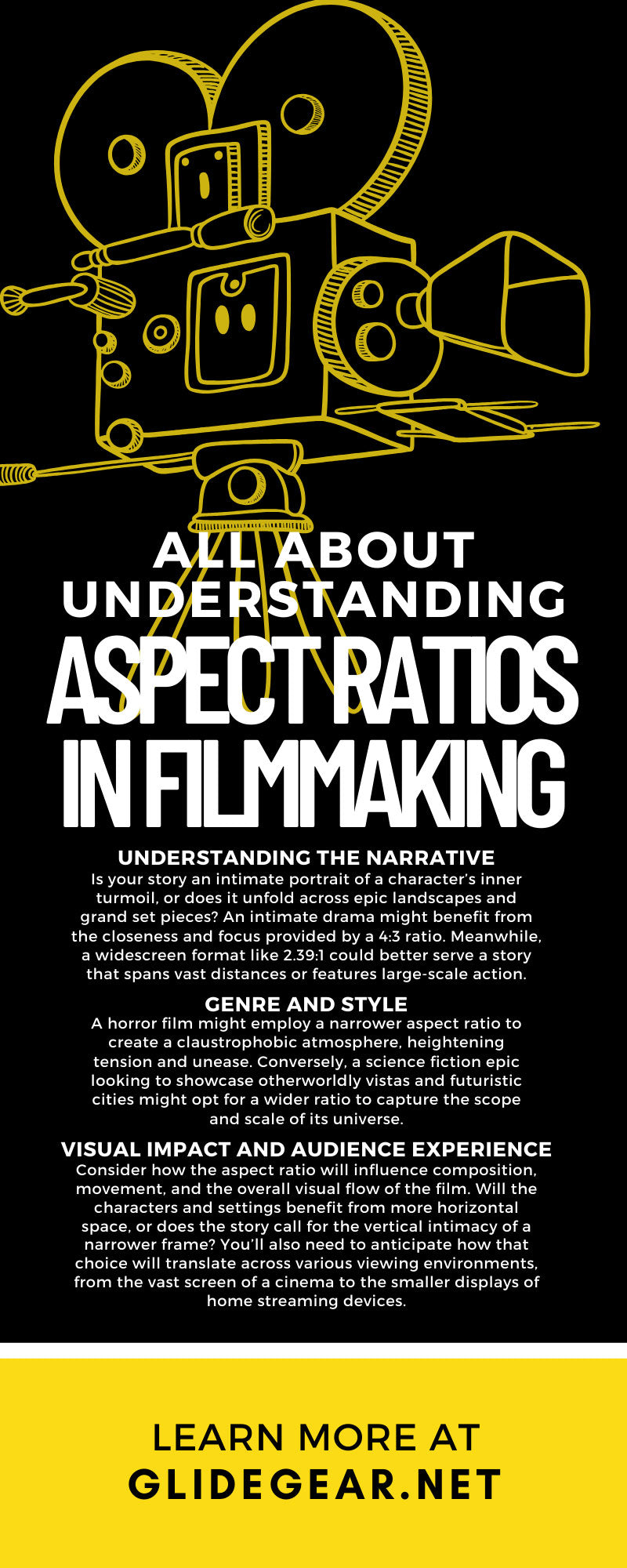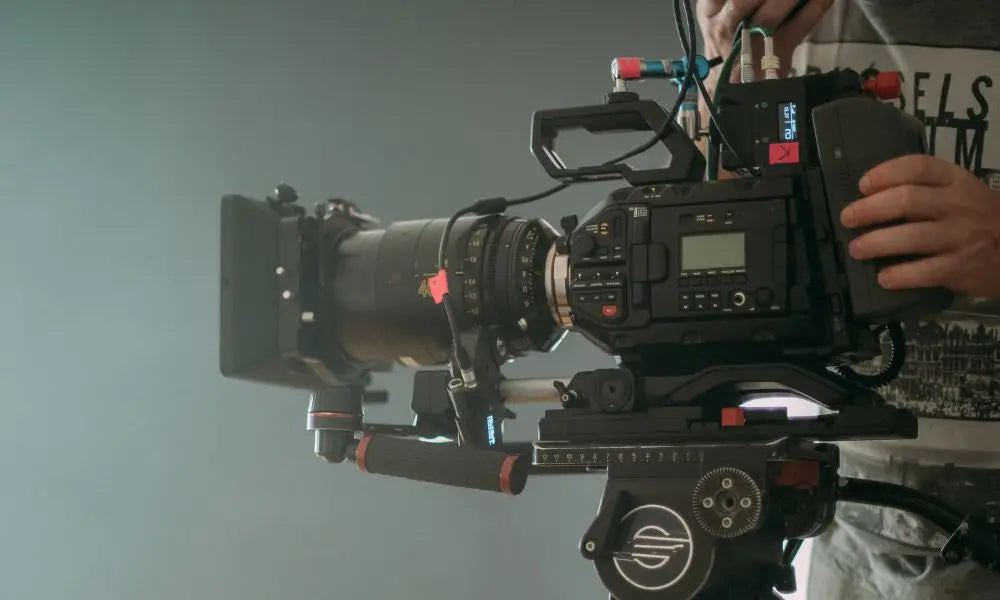All About Understanding Aspect Ratios in Filmmaking
Step into the realm of filmmaking and you’ll quickly notice that aspect ratios play a pivotal role in shaping our viewing experiences. Far more than just technical jargon, these visual parameters influence every frame of the film.
Imagine transforming the wide, open landscapes of a classic Western to fit within a square frame. The storytelling impact would not just shift—it would fundamentally change. Directors and cinematographers choose their visual boundaries carefully, determining how much of their created world we see and, consequently, how we feel about it.
Our focus here goes beyond simple numbers and formats to provide an understanding of aspect ratios in the art of filmmaking. Each decision regarding these visual parameters directly affects the audience’s emotional response, making aspect ratios a key tool for filmmakers.
What Is an Aspect Ratio?
In filmmaking, an aspect ratio refers to the relationship between the width and height of the image displayed on screen. It’s represented by two numbers separated by a colon, indicating how much wider an image is than it is tall. The aspect ratio determines how much of the story’s world the audience gets to see and plays a significant role in guiding viewers’ focus within the frame. A few common aspect ratios used in film include:
4:3
Often associated with the classic era of film and television, the 4:3 aspect ratio, also known as the Academy ratio, was the standard for many years. Its nearly square shape offers a sense of intimacy and focus, making it ideal for character-driven stories and close-up shots that require a personal touch.
1.85:1
This ratio strikes a balance between widescreen and more traditional formats, and is common in both US and British films. It provides filmmakers with enough horizontal space to play with dynamic compositions without losing the ability to focus closely on characters and finer details.
2.39:1
Known as the CinemaScope or widescreen ratio, this format offers a broad canvas for filmmakers to work with. It’s especially favored for epic landscapes, grand set pieces, and scenes that benefit from a vast field of view. The expansive nature of this aspect ratio can immerse viewers in the film’s world, making it a go-to for big-budget blockbusters, sweeping dramas, and adventure films.
16:9
With the advent of digital filmmaking and high-definition broadcasting, the 16:9 aspect ratio has become a standard for modern televisions, streaming content, and even some theatrical releases. It offers a comfortable middle ground between the traditional and widescreen formats, accommodating both the cinematic feel of wider ratios and the more intimate framing of narrower ones.
Significance in Storytelling
An aspect ratio acts as a frame through which the story unfolds, and its dimensions can dramatically affect how viewers interact with the narrative. You can experiment with professional video equipment to achieve these effects.
Intimacy vs. Epic Scale
The decision between a narrower aspect ratio, like 4:3, and a wider one, like 2.39:1, fundamentally shapes the narrative’s presentation. A 4:3 frame can wrap viewers in a cloak of intimacy, directing their gaze to characters’ emotions; the closeness of the frame mirrors the internal focus of the narrative.
Meanwhile, the wide expanses offered by ratios like 2.39:1 immerse audiences in the film’s setting, whether it’s the vastness of outer space or the sprawling vistas of a fantasy world. Such a broad canvas heightens the narrative’s epic quality, making every triumph and tragedy resonate on a grander scale.
Time Travel Through Ratios
Aspect ratios also serve as time machines, evoking distinct eras or styles. The classic 4:3 ratio might whisk viewers away to the golden age of Hollywood, adding a layer of nostalgia or historical authenticity to period pieces or films aiming for an old-fashioned aesthetic. It’s a visual cue that can subtly influence the audience’s perception of the story’s context and mood.
Dynamic Storytelling
Some filmmakers break traditional boundaries by varying aspect ratios throughout a film. This technique can delineate different timelines, realities, or perspectives, providing visual cues that guide audience understanding. For example, transitioning from a wider to a narrower frame might signal a shift from objective to subjective reality, drawing viewers closer into a character’s personal experience.
Choosing the Right Aspect Ratio
When it comes to selecting the perfect aspect ratio for a film, you face a decision as critical as casting or location selection. This choice affects the visual aesthetics of the movie as well as its storytelling power and audience engagement.
Understanding the Narrative
Is your story an intimate portrait of a character’s inner turmoil, or does it unfold across epic landscapes and grand set pieces? An intimate drama might benefit from the closeness and focus provided by a 4:3 ratio. Meanwhile, a widescreen format like 2.39:1 could better serve a story that spans vast distances or features large-scale action.
Genre and Style
What genre are you working with? A horror film might employ a narrower aspect ratio to create a claustrophobic atmosphere, heightening tension and unease. Conversely, a science fiction epic looking to showcase otherworldly vistas and futuristic cities might opt for a wider ratio to capture the scope and scale of its universe.
Visual Impact and Audience Experience
Consider how the aspect ratio will influence composition, movement, and the overall visual flow of the film. Will the characters and settings benefit from more horizontal space, or does the story call for the vertical intimacy of a narrower frame? You’ll also need to anticipate how that choice will translate across various viewing environments, from the vast screen of a cinema to the smaller displays of home streaming devices.
What Does It All Mean for You?
Understanding all about aspect ratios in filmmaking unveils a realm where technical detail and creative vision intersect. This deep dive demonstrates how you can wield aspect ratios not merely as tools for composition but as vital storytelling elements. Whether you’re shooting for expansive widescreens or narrower frames, you have the power to directly influence the viewers’ journey.
These decisions, subtle yet significant, underline the beauty and history of cinema. They stand as testaments to the filmmaker’s intent, playing crucial roles in both narrative construction and visual impact.
A thorough grasp of aspect ratios offers a richer cinematic experience. It opens our eyes to the artistry behind beloved films, enhancing our connection to their narratives. Through this perspective, we come to appreciate cinema’s power to stir emotions and communicate ideas, one frame at a time.




